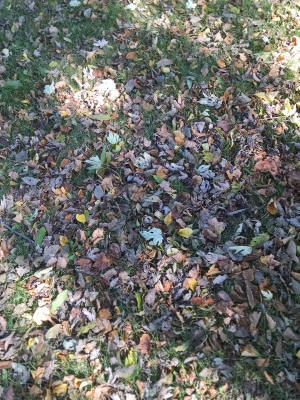|
 Column Column
Fall Leaf Management
By John Fulton
 Send a link to a friend
Send a link to a friend
[October 22, 2016]
Mid-October, and a bit of wind, leads
to falling leaves in increasing numbers. This brings up one of those
age old questions “What do I do with all those leaves?” This brings
about one of the “dust it off and re-use” columns. The simple answer
is to give you three options: leave them (no pun intended), remove
them, or chop them up.
|
|
 If you decide to let nature take its course, letting leaves lie
brings benefits and some problems. Many of the benefits are
associated with your labor, or lack of it. The major non-labor
benefit is when leaves collect in flower beds and around shrubs
to provide a mulch for those plants. Problems generally develop
where deep piles of leaves may smother grass or harbor diseases,
causing large dead areas to deal with next spring. Of course if
you are the only resident in a neighborhood who doesn’t rake
leaves, you may be talked about at many social functions this
fall. If you decide to let nature take its course, letting leaves lie
brings benefits and some problems. Many of the benefits are
associated with your labor, or lack of it. The major non-labor
benefit is when leaves collect in flower beds and around shrubs
to provide a mulch for those plants. Problems generally develop
where deep piles of leaves may smother grass or harbor diseases,
causing large dead areas to deal with next spring. Of course if
you are the only resident in a neighborhood who doesn’t rake
leaves, you may be talked about at many social functions this
fall.
Removing leaves is generally done by raking or bagging with a
mower attachment. This makes your lawn look neat, prevents
problems for lawns, and gives you a workout if you are manually
raking. The main problems are the time, labor, and disposal of
the leaves when they are piled.
Chopping leaves means reducing the size. Benefits include less
smothering, quicker breakdown, and less labor. The main drawback
comes with deep piles that still should be removed because of
trouble in shredding and smothering. Early in the season, simply
mowing leaves provides a good option.

One thing to consider is the type of leaves. There is a huge
difference in oak leaves and silver maple leaves. It’s difficult
to have smothering problems with oak leaves, while silver maple
leaves may smother with a very thin layer. Many green leaves
were blown down Sunday with the high winds. These green leaves
will tend to smother more than the dry, rigid types will.
What do you do with the leaves you’ve accumulated? There are
several possibilities. Many municipalities, prohibit burning for
the most part. Besides the fire risk, the respiratory issues for
affected people can be life threatening. Raking leaves into the
street, unless requested by the city for cleanup, usually
results in clogging storm sewers.
[to top of second column] |

Options remaining include composting, using as mulch, tilling into
garden and bed areas, and hauling to the city landscape
recycling dump. There may even be some private collection
services that will take bagged leaves to a recycling center.
Partial composting, and the subsequent use as mulch, is one of
the best solutions. Simply construct an enclosure at least two
feet cubed, place leaves in it, and cover the top with hardware
cloth or wire laid on it and weighted down. The resulting much
may be used next spring on flower beds, gardens, around trees
and shrubs, or spread back on gardens or lawns.
One thing to consider is removing the leaves from around the
foundation of the house. The decaying leaves provide a hiding
place or food sources for nuisance pests such as lady bugs and
millipedes. The removal from directly around the house may
reduce the number of these insects making their way into your
home. A foundation spray of an insecticide such as permethrin
will also reduce numbers coming into the home.
This will be the last regular offering for the year. Once again,
I’ve enjoyed providing the material. If you would like more
information on horticulture or other topics topics, please check
out our website at
http://web.extension.illinois.edu/lms/
[By JOHN FULTON, COUNTY EXTENSION
DIRECTOR SERVING LOGAN, MENARD, AND SANGAMON COUNTIES]
 |